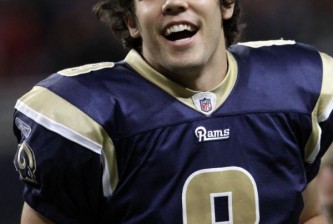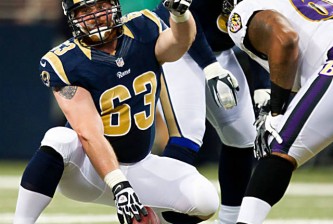
Now that the Redskins’ trade is official, Les Snead and the St Louis Rams have to reset their draft board, surveying the talent landscape around the sixth pick. And there they have a problem: the draft landscape is littered with guys who are basically replaceable by other talent later in the draft. If Justin Blackmon is your #1 WR, you have a 1A in Michael Floyd, 1B in Kendall Wright, and acceptable 2s in players like Marvin Jones. If you are thinking DT, you have Devon Still and Fletcher Cox competing for “most polished” while Dontari Poe and Michael Brockers battle for “tantalizing upside” … without any of them head and shoulders above the other.
Moreover, by the time the sixth pick rolls up, the unique talents – Ryan Kalil, Morris Claiborne, Trent Richardson – stand a good chance of being off the board. So if the Rams are thinking “best player available,” as well they should, there is one guy who is undeniably the best at his position: Stanford guard David Decastro.
“A guard? Picked sixth overall? That’s wayyyyy too early!”
So the conventional wisdom goes. But the conventions are changing under our feet, with the reinstatement of sanity among rookie pay. For most of the last twenty years, players taken in the top of the first round had to return “marquee” value to justify their outlandish salaries. One way or the other, they had to move turnstiles. In other words, they have to be (a) a quarterback, (b) a quarterback’s best friend (left tackle or elite wide receiver), or (c) a quarterback’s worst nightmare (pass-rushing monster or uber-elite cornerback).
We’ve grown up with a generation of NFL drafts that haven’t seen an interior lineman drafted higher than 10 (Chris Naeole, 9-year starter for the Saints and Jaguars, picked in 1997). But prior to the modern salary cap era (i.e. “crazy money for draft picks” era), picking guards in the top ten was a common occurence.
One of those, Mike Munchak, was drafted 8th overall in 1982. Munchak was a key cog of Jeff Fisher’s offense in Houston, and later became his offensive line coach as the Oilers moved to Tennessee. Of course, Munchak now coaches the Titans, after Fisher stepped down.
Bottom line, when you’re picking in the top ten, you’d better be getting a perennial Pro Bowler. Or, as fellow writer Tim Shields puts it: “If you take someone at 6, you shouldn’t have to touch that position for a while. That’s why I like Claiborne, Kalil and Decastro best at 6.”
This pick becomes even more enticing when considering the recent free agency signing of Scott Wells to play center. Pairing Wells with Harvey Dahl shores up two thirds of the middle of the line. Bringing DeCastro in at left guard would suddenly make that middle rock-solid, and would likely help Rodger Saffold with those tricky inside rushers too.
Of course, options remain wide open at six, including the possibility of trading down again. But in a scenario where the blue-chippers are whittled away, taking the best blue-chip guard prospect the game has seen since Mike Iupati is a tempting idea.






















